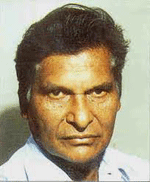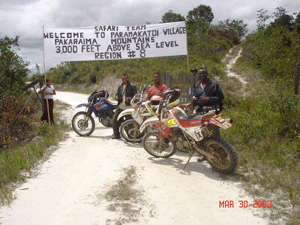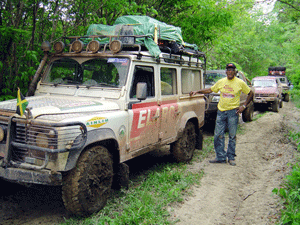–this year’s event in memory of Dr. Cheddi Jagan
THE amazing story of development in the hinterland regions transforming the quality of life of Guyana’s first peoples is largely symbiotic with the life and works of Harripersaud Nokta — a veteran of political struggle in Guyana and former Senior Minister holding the portfolios of Public Works, Communications and Regional Development,  and of Local Government and Regional Development, as well as acting Minister of Agriculture following the murder of Minister Satyadeow (Sash) Sawh.
and of Local Government and Regional Development, as well as acting Minister of Agriculture following the murder of Minister Satyadeow (Sash) Sawh.
Documenting some of his experiences on that hinterland transformational journey, Nokta takes one on a adventurous voyage of discovery viewed through the eyes of his photographic memory and related through his pen in his first book, entitled “The Road: A Patamona Dream.”
This dream is now being lived by many intrepid visitors to Guyana’s hinterland communities, many of which were once almost inaccessible until Harripersaud Nokta and the PPP/C government created facilitating mechanisms to change the equation, whereby Amerindian communities no longer live in isolation and removed from the national development paradigm, but are integral to the processes involved in expanding Guyana’s growth dynamics.
Following are excerpts from “The Road: A Patamona Dream”, which vividly describes a dream in the process of realization, which is the genesis of many good things, primary among them being the Ministry of Tourism’s calendar event, the Pakaraima Mountain Safari:
“The victory of the PPP/Civic in the October 5, 1992 general and regional elections brought about the restoration of democracy and the dawn of a new era for the Guyanese people generally, and in particular the Amerindians.
“As Minister of Public Works, Communication and Regional Development, and having first-hand knowledge and experience of the sufferings of the people of Region Eight, I recognized that it was my duty to do something to end the travails of a people who had, for centuries, been walking up and down rocky mountains and valleys, and swimming across rivers when the water was high to get from one village to another.
“The need for a road to link the various villages was paramount in my mind. I arranged with Desmond Kissoon, PPP activist and Regional Chairman of Region Nine, to undertake a walking expedition for the purpose of establishing an alignment through friendly (interaction) from one village to the other, to construct a road to link villages in the North and South Pakaraimas.
 |
 |
| Flashback: On the Safari trail in previous years | |
“I knew it was going to be a difficult task, but realised that with determination and help from the villagers and the government’s input, a road link could be established.”
Now, those were all largely forested, uncharted territories; so, obviously, demographics and topography had to be explored to determine a practical route, certainly no easy task, as Nokta explained as follows:
“According to arrangements, Mr. Kissoon and GDF Lieutenant Leitch from Lethem travelled to Monkey Mountain through Brazil, while Mr. Elmo Edwards, DDO, and Amahad Raphael, another Amerindian from Karasabai, travelled to Monkey Mountain with two pack horses. By nightfall, both parties (had) joined me at Mountain Mountain.
“Early next morning, my gruelling trek began with Kissoon, the GDF officer, Edwards and Raphael, who served as the lead person.
“We walked down the very steep Monkey Mountain, hopping and jumping from rock to rock, through thick forest, until we reached the edge of the Echilibar River, which divides Regions Eight and Nine.
“Along the way, we went through narrow ravines, sharing jokes, and by 3.30 pm, we reached Yerong Paru, the first village in Region Nine.
“Day 2: At 6.30 am, we were on the trail that winds up and down the Yerong Paru Mountain, and a good three hours’ steady walk under tall trees brought us to Morabaiko Creek, where we took a welcome refreshing dip in the cool, clear water which flowed from the mountains.
“After a light meal and rest, we set out walking in open savannah, braving the heat of a hot, sunny day.
“We arrived at Rukhmuta and rested until about 5.00 pm ….
“Walking through open savannah in the hot sun is more fatiguing than through forest with high trees. One gets thirsty quickly, and excessive perspiring can result in cramps of the body.
“Day 3: By 6.30 am, we were all ready again to start our journey to the next village, called Tipuru.
“Day 4: …….Mr. Edwards, with his practical knowledge of the terrain, briefly recapped our journey, and in his own way (influenced) me that a road was possible, retracing the trail and pointing out how an alignment (could) be charted through friendly territory to avoid too low or too steep areas to move through.
“We left for Karasabai, hoping to get there before sundown….
“The Tipuru Mountain was a test of our endurance, and we had to rest regularly as we slowly moved to the top. We then negotiated the long trek downwards, slipping on small, rough rocks which slowed our pace.
“Day 5: As we walked over the Karabaiko Mountain into flat terrain on our way to Karasabai, the horses began moving faster, and we stepped up the pace.”
“Day 6: At 7.30 am, we started from Karasabai, and this time there was no need for horses.
“By 9.30 am, a meeting was held at Tiger Pond Village, and then the team left for a small community named Pipang, just at the bottom of the Taushida Mountain.
“Soon after our little discussion with some residents, we began climbing up the steep Taushida Mountain, and got to the top without problem.”
It was a gruelling eight days’ journey, starting at Monkey Mountain and ending at Lethem, but this opened the way for the establishment of a road linking all the villages in North and South Pakaraimas in Regions Eight and Nine.
“It was agreed that we would clear a track from one end to the other to link each village, and this took a few months.
“The foot track was widened to about three-to-four-feet on each side, and this took even more time, requiring mobilization of manpower, money, food, equipment and tools – all of which were scarce.
“But, gradually, within two years, the foot track was transformed into a rough trail linking all the villages from Karasabai to Orinduik.
“It was amazing that the Patamonas, generally people of short stature, were like ‘mandozers’ in the energy they put into making their dream come true with the barest of tools. But with great efforts and much sacrifice, their hopes materialized.
“With support from the Regional Administrators of Regions Eight and Nine, Captains, Councillors and villagers alike, a road alignment was charted and road construction started.
“It called for much human muscle, time, labour and sacrifice without consultants, bulldozers, front-end loaders or trucks.
“But a road link was constructed, and in less than four years, vehicular traffic began – first by tractors and trailers, then by other four-wheel-drive vehicles.
“With meagre resources, the REO of Region Nine, Mr. Dayaljee Persaud, was able to have the top of Taushida Mountain graded and leveled, and a road was constructed from Toka Village to the foot of Taushida Mountain.
“Due to a lack of foresight, poor evaluation of the benefits to be derived, and to a great extent prejudice by then Regional Chairman of Region Nine and the Captain of Toka Village and others, that portion of the road is left to be completed. Hopefully, some day it will be done, so that Toka in the North Savannah will be linked to Taushida, Pipang, Tiger Pond and Karasabai, and continue to other villages in the North Pakaraimas, reaching as far as Orinduik, and then continuing to Kopinang and Maikwak.
“Notwithstanding that, the dream of the Patamona people was fulfilled…….
“Construction of the access road was started by using local labour and simple agricultural tools. It began as a rough foot path, and made way for two tractors and trailers provided by the Regional Administration of Region Eight.
“It must be recorded that, for the first two tractors to get into Kato in Region Eight, they had to be driven from Lethem into Brazilian territory, and across the Ireng River at a shallow point at Mutung on the Brazilian side, then to Kato – a journey that took several weeks.
“In 2003, the historic first Pakaraima Safari, dedicated to the memory of Dr. Jagan, was undertaken.”



.jpg)








